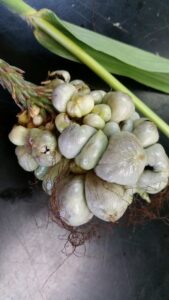There have been numerous reports of corn smut throughout the state of New Jersey the past few weeks.
Corn smut (also called common smut), caused by Ustilago maydis, is found infecting corn throughout most of the world. In most years, corn smut is reported in New Jersey , but reports are limited to just a few plantings and just a few ears of corn. Corn smut gets its name from the sooty, black masses of teliospores that found on infected plants. Symptoms are tumor-like galls that vary in size from less than 1 cm to more than 30 cm in diameter. All meristematic tissues are susceptible to infection; and galls can develop on ears, tassels, stalks, shoots, and mid-ribs of infected plants (Pataky and Snetselaar, 2006). From the time of infection, it takes about 10 days for early symptoms to show up; followed up with a maturation of black spore masses within swollen galls about three weeks after infection (Figure 1).

Figure 1. Corn smut.
The fungus can overwinter as teliospores in crop debris or the soil and remain viable for many years. It is thought that the teliospores (i.e. the black spores – it is estimated that up to 200 billion spores are produced in a medium-size gall!) are unimportant in the summer they are produced, but more importantly act to overwinter and cause infections the next growing season (Pataky and Snetselaar, 2006) .
There is no general agreement on weather conditions that are most favorable for common smut, although most reports indicate that common smut is prevalent following rainy, humid weather (Pataky and Snetselaar, 2006). Galls on leaves and stalks of seedlings often are observed following strong thunderstorms with heavy winds, especially when plants are injured by blowing soil (Pataky and Snetselaar, 2006). Factors that reduce the production of pollen or inhibit pollination also increase the occurrence of ear galls of common smut. Thus, hot, dry, drought-like conditions often cause asynchronous pollen production and silk emergence which results in poor pollination and common smut may be prevalent if U. maydis is readily disseminated to stigmas of unfertilized ovaries during or immediately following these hot, dry conditions (Pataky and Snetselaar, 2006). Thus, some associate the occurrence of ear galls with droughts although the droughts probably affect the prevalence of ear galls primarily by increasing the number of unpollinated ovaries with rapidly growing silks (Pataky and Snetselaar, 2006).
Although there has been a great amount of research in controlling corn smut with fungicides (c0nventional and biological), adjusting fertility, crop rotation, sanitation, and seed treatments, the best management practice for limiting losses due to corn smut are planting smut resistant corn varieties (Pataky and Snetselaar, 2006). Although, none are completely resistant to the pathogen.
Unfortunately, for much of New Jersey this summer the weather conditions (the extended drought-like conditions in July) followed by the heavy isolated rains leading most likely to poor pollination periods and timing of corn smut infections led to the situation we are seeing now. Growers with significant smut issues might consider removing and destroying smutted ears to reduce inoculum loads, plan on choosing sweet corn varieties with resistance next year, and changing irrigation practices to help reduce crop stress during pollination periods.
References:
Pataky, J. and Snetselaar, K. 2006. Common smut of corn (Syn. boil smut, blister smut). Plant Disease Profiles, The Plant Health Instructor. Volume 6. <doi.org/10.1094/PHI-I-2006-0927-01>
For more detailed information on corn smut, it’s biology, and history please see the link to the following article referenced above by Jerald Pataky and Karen Snetselaar at The Plant Health Instructor Website hosted by APS.
https://www.apsnet.org/edcenter/disandpath/fungalbasidio/pdlessons/Pages/CornSmut.aspx
